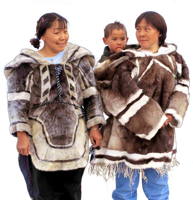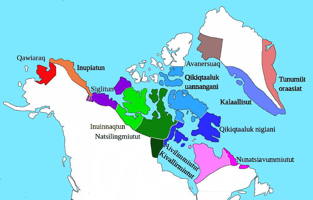
|
The Society of Folk Dance Historians (SFDH) Inuit
[
Home |
About |
Encyclopedia | CLICK AN IMAGE TO ENLARGE |

|
 The Inuit are indigenous people who make their homes in the Arctic and subarctic regions of Siberia and North America. This includes the various groups of indigenous peoples within Canada, who live throughout the Inuvialuit Settlement Region of the Northwest Territories and the new Canada Territory of Nunavut, Nunavik in northern Quebec (also known as Inuit Nunangat) and Nunatsiavut in Labrador (also known as NunatuKavut).
The Inuit are indigenous people who make their homes in the Arctic and subarctic regions of Siberia and North America. This includes the various groups of indigenous peoples within Canada, who live throughout the Inuvialuit Settlement Region of the Northwest Territories and the new Canada Territory of Nunavut, Nunavik in northern Quebec (also known as Inuit Nunangat) and Nunatsiavut in Labrador (also known as NunatuKavut).
"Inuit" means "people." "Inuit" is the plural of "Inuk" meaning "person," and "Yupik" is a singular word meaning "real person" based on the root word "yuk” meaning "person." The primary reason some people consider Eskimo derogatory is the questionable but widespread perception that in some languages it means "eaters of raw meat."
The traditional lifestyle of the Inuit is adapted to extreme climatic conditions; their essential skills for survival are hunting and trapping, as well as the construction of fur clothing for survival. Agriculture was never possible in the millions of square kilometres of tundra and icy coasts from Siberia to Northern America including Greenland. Therefore, hunting became the core of the culture and cultural history of the Inuit. They used harpoons, bows and arrows, and to take down animals of all sizes.
Many elders still remember the time, more than 60 years ago, when the Inuit lived a nomadic lifestyle. Depending on the seasons (up to sixteen according to old traditions), they followed the animals they hunted for clothing and nourishment. They had to relocate and reconstruct their camps frequently and followed the same traditions for generations.
At the turn to the 20th century, most Inuit still lived in hide tents during the summer. Sometimes, they already owned canvas tents obtained from the Hudson's Bay Company. The interior was divided into a back part used for sleeping, usually raised by coat underlays, and a front part for cooking and living; a tradition still in practice today. The woman's sleeping place was always beside the kudlik, an oil lamp usually carved from soapstone used for lighting, heating and cooking, because it was her duty to operate it. The man's sleeping place was near the weapons and hunting equipment; the children were nestled between their parents for warmth. Today the kudlik is replaced by a product of modern industry, the Coleman stove, which is easy to transport and operated by gasoline and naphtha.
Big hopes were put into the establishment of cooperatives, today the Arctic Co-operatives Limited, that were to help convey to the Inuit the skills of creating added value, so they would take care of themselves again and at the same time preserve their traditional culture. These cooperatives, mostly managed by Qallunaat (non-Inuit), did in fact prove very successful, because they succeeded in connecting economic thinking with traditional activities and values not only theoretically.
This page © 2018 by Ron Houston.
Please do not copy any part of this page without including this copyright notice.
Please do not copy small portions out of context.
Please do not copy large portions without permission from Ron Houston.